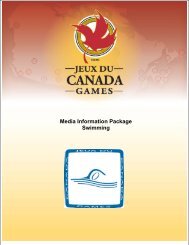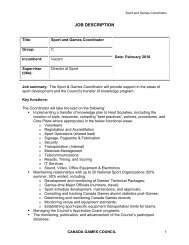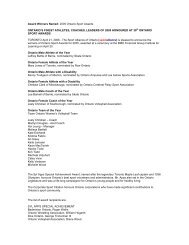Targets for Athlete Performance and the Sport System
Targets for Athlete Performance and the Sport System
Targets for Athlete Performance and the Sport System
Create successful ePaper yourself
Turn your PDF publications into a flip-book with our unique Google optimized e-Paper software.
Finally, some sports recognize that specialized technical instruction is required, in addition<br />
to full time coaching. Synchronized swimming, <strong>for</strong> example, made requests <strong>for</strong> specialized<br />
instruction in acrobatics, ballet, as well as choreography. Men’s field hockey has plans to bring in<br />
specialists (recent <strong>and</strong> <strong>for</strong>mer international players) to instruct on critical tactics (ie. penalty<br />
corners) that could prove invaluable <strong>for</strong> success at international competition. This direction was<br />
viewed by <strong>the</strong> SRC as an example of enhanced programming that would give Canadian athletes <strong>the</strong><br />
edge needed to produce podium per<strong>for</strong>mances in <strong>the</strong> future.<br />
Coaching is not adequately developed as a profession in Canada to provide <strong>the</strong> stability to<br />
consistently achieve per<strong>for</strong>mance results at major international competition. Too many coaches are<br />
surviving through one-year contracts under multi-partner cost-sharing models. This is a priority <strong>for</strong><br />
<strong>the</strong> Canadian <strong>Sport</strong> system to resolve be<strong>for</strong>e per<strong>for</strong>mance excellence can be consistently<br />
maintained.<br />
Work Group #4 is aware of <strong>the</strong> work of <strong>the</strong> Coaching Implementation Group (CIG) that is<br />
currently under consideration <strong>and</strong> is supportive of most of <strong>the</strong> recommendations as <strong>the</strong>y relate to an<br />
increased investment in coaching.<br />
Coaching Recommendations: Work Group #4 recommends that funding <strong>for</strong> coaching<br />
support should be allocated on a more long term basis so that more professional coaching<br />
opportunities, defined as full time, multi-year contracts that include professional<br />
development opportunities <strong>and</strong> benefits, can be created <strong>for</strong> national team coaches. A national<br />
funding partner coordinating body, similar to <strong>the</strong> SRP, should have <strong>the</strong> responsibility of assessing<br />
<strong>the</strong> coaching needs of sports <strong>and</strong> ensuring that adequate funding is allocated to meet <strong>the</strong> high<br />
per<strong>for</strong>mance coaching needs of priority sports. Fur<strong>the</strong>r, <strong>the</strong> CIG recommendations related to <strong>the</strong><br />
increased investment in coaching salaries are referred to by Work Group #4 <strong>for</strong> implementation.<br />
2. Strategic Investment in <strong>Sport</strong><br />
International research on sport development systems indicates that successful sporting<br />
nations target resources on a relatively small number of priority sports with potential <strong>for</strong><br />
international success. International best practices of this would include Australia, <strong>the</strong> U.K., <strong>and</strong><br />
Norway, which target resources on 8-30 sports. France uses a similar approach, but unlike <strong>the</strong><br />
o<strong>the</strong>rs, which focus primarily on ei<strong>the</strong>r summer or winter sports, invests in both summer <strong>and</strong> winter<br />
sports.<br />
In Canada, <strong>Sport</strong> Canada funding is primarily egalitarian, with only minimal funding<br />
targeted on athletes <strong>and</strong> teams with medal potential through special programs (i.e. SRP, Podium<br />
2002). There is an underst<strong>and</strong>ing <strong>and</strong> acceptance in <strong>the</strong> Canadian sport community that grass roots<br />
sport <strong>and</strong> mass participation can drive high per<strong>for</strong>mance success. That is, <strong>the</strong> larger <strong>the</strong> base of <strong>the</strong><br />
pyramid, <strong>the</strong> larger <strong>the</strong> number of world-class athletes produced.<br />
Less commonly accepted, <strong>and</strong> exploited, is that high per<strong>for</strong>mance success can drive grass<br />
roots growth. The growth in girls <strong>and</strong> women’s soccer <strong>and</strong> hockey has been driven in part by <strong>the</strong><br />
success of <strong>the</strong> national team. More interest in Triathlon, Beach Volleyball, Wrestling <strong>and</strong> Judo can<br />
also be associated with recent success at <strong>the</strong> international level.<br />
Recommendations: It is unrealistic to expect that a country with such a small population<br />
(33M) can support mass participation in all <strong>the</strong> Olympic <strong>and</strong> Paralympic <strong>Sport</strong>s. Not all sports can<br />
achieve <strong>the</strong> mass participation levels of <strong>the</strong> most popular sports in Canada (soccer, hockey etc).<br />
<strong>Athlete</strong> Per<strong>for</strong>mance <strong>and</strong> <strong>Sport</strong> <strong>System</strong> <strong>Targets</strong>, Evaluation, <strong>and</strong> Investment Page 36





